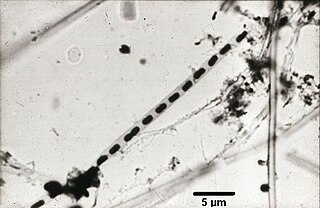
Phytophthora is a genus of plant-damaging oomycetes, whose member species are capable of causing enormous economic losses on crops worldwide, as well as environmental damage in natural ecosystems. The cell wall of Phytophthora is made up of cellulose. The genus was first described by Heinrich Anton de Bary in 1875. Approximately 170 species have been described, although 100–500 undiscovered Phytophthora species are estimated to exist.

The Burkholderiales are an order of Proteobacteria. Like all Proteobacteria, they are Gram-negative. They include several pathogenic bacteria, including species of Burkholderia, Bordetella, and Ralstonia. They also include Oxalobacter and related genera, which are unusual in using oxalic acid as their source of carbon. Other well-studied genera include Alcaligenes, Cupriavidus, Achromobacter, Comamonas, Delftia, Massilia, Duganella, Janthinobacterium, Polynucleobacter, non-pathogenic Paraburkholderia, Caballeronia, Polaromonas, Thiomonas, Collimonas, Hydrogenophaga, Sphaerotilus, Variovorax, Acidovorax, Rubrivivax and Rhodoferax, and Herbaspirillum.

The Comamonadaceae are a family of the Betaproteobacteria. Like all Proteobacteria, they are Gram-negative. They are aerobic and most of the species are motile via flagella. The cells are curved rod-shaped.
Callulops humicola is a species of frog in the family Microhylidae. It is endemic to Papua New Guinea. Its natural habitats are subtropical or tropical moist montane forests and heavily degraded former forest. It is threatened by habitat loss.

The dusky-tailed canastero is a species of bird in the family Furnariidae. It is found in Chile. Its natural habitats are subtropical or tropical dry shrubland and subtropical or tropical high-altitude shrubland.
Copernicia humicola is a palm which is endemic to Cuba.

Clavulina is a genus of fungus in the family Clavulinaceae, in the Cantharelloid clade. Species are characterized by having extensively branched fruit bodies, white spore prints, and bisterigmate basidia. Branches are cylindrical or flattened, blunt, and pointed or crested at the apex, hyphae with or without clamps, basidia cylindrical to narrowly clavate, mostly with two sterigmata which are large and strongly incurved and spores subspherical or broadly ellipsoid, smooth, and thin-walled, each with one large oil drop or guttule. The genus contains approximately forty-five species with a worldwide distribution, primarily in tropical regions. Species of Clavulina are mostly ectomycorrhizal. A recent study has identified Clavulina to the genera level as present on Nothofagus menziesii adventitious roots

Variovorax is a Gram-negative and motile genus of bacteria from the family Comamonadaceae.
Variovorax boronicumulans is a Gram-negative, catalase- and oxidase-positive, non-spore-forming, rod-shaped, motile bacterium from the genus Variovorax. Colonies of V. boronicumulans are yellow in color.
Variovorax defluvii is a Gram-negative, non-spore-forming, motile bacterium from the genus Variovorax, which was isolated from the sewage in the Geumho River in Korea.
Variovorax dokdonensis is a Gram-negative, motile bacterium from the genus Variovorax, which was isolated from soil in Dokdo in Korea. Colonies of V. dokdonensis are yellow in color.
Variovorax ginsengisoli is a Gram-negative, non-spore-forming, rod-shaped, motile bacterium from the genus Variovorax, which was isolated from soil from a ginseng field in Pocheon in South Korea. Colonies of V. ginsengisoli are yellowish in color.
Variovorax paradoxus is a gram negative, beta proteobacterium from the genus Variovorax. Strains of V. paradoxus can be categorized into two groups, hydrogen oxidizers and heterotrophic strains, both of which are aerobic. The genus name Vario-vorax and species name para-doxus (contrary-opinion) reflects both the dichotomy of V. paradoxus metabolisms, but also its ability to utilize a wide array of organic compounds.
Variovorax soli is a Gram-negative, catalase- and oxidase-positive, rod-shaped, non-spore-forming, motile bacterium from the genus Variovorax, which was isolated from greenhouse soil. Colonies of Variovorax soli are light yellow in color.
Arthrobacter humicola is a Gram-positive bacterium species from the genus of Arthrobacter which has been isolated from soil in Japan.
Arthrobacter oryzae is a Gram-positive bacterium species from the genus of Arthrobacter which has been isolated from soil in Japan.
Variovorax gossypii is a Gram-negative and small rod-shaped bacterium from the genus of Variovorax which has been isolated from the plant Gossypium hirsutum from Tallassee in the United States.
Variovorax guangxiensis is an aerobic bacterium from the genus of Variovorax which has been isolated from rhizosphere soil of a banana tree from Guangxi in China. Variovorax guangxiensis produces 1-aminocyclopropane-1-carboxylate deaminase.
Humicola is a genus of fungi belonging to the family Chaetomiaceae.
Cophixalus humicola is a species of microhylid frog endemic to the Papua Province in New Guinea. It was described by Rainer Günter in 2006.





